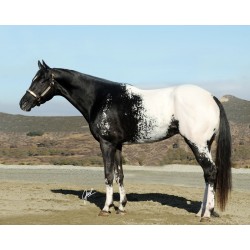





















The Appaloosa is an American horse breed best known for its colorful spotted coat pattern. There is a wide range of body types within the breed, stemming from the influence of multiple breeds of horses throughout its history.
 Security policy (edit with Customer reassurance module)
Security policy (edit with Customer reassurance module)
 Delivery policy (edit with Customer reassurance module)
Delivery policy (edit with Customer reassurance module)
 Return policy (edit with Customer reassurance module)
Return policy (edit with Customer reassurance module)
The Appaloosa is an American horse breed best known for its colorful spotted coat pattern. There is a wide range of body types within the breed, stemming from the influence of multiple breeds of horses throughout its history. Each horse's color pattern is genetically the result of various spotting patterns overlaid on top of one of several recognized base coat colors. The color pattern of the Appaloosa is of interest to those who study equine coat color genetics, as it and several other physical characteristics are linked to the leopard complex mutation (LP). Appaloosas are prone to develop equine recurrent uveitis and congenital stationary night blindness; the latter has been linked to the leopard complex.
Artwork depicting prehistoric horses with leopard spotting exists in prehistoric cave paintings in Europe. Images of domesticated horses with leopard spotting patterns appeared in artwork from Ancient Greece and Han dynasty China through the early modern period. In North America, the Nez Perce people of what today is the United States Pacific Northwest developed the original American breed. Settlers once referred to these spotted horses as the "Palouse horse", possibly after the Palouse River, which ran through the heart of Nez Perce country. Gradually, the name evolved into "Appaloosa".
The Nez Perce lost most of their horses after the Nez Perce War in 1877, and the breed fell into decline for several decades. A small number of dedicated breeders preserved the Appaloosa as a distinct breed until the Appaloosa Horse Club (ApHC) was formed as the breed registry in 1938. The modern breed maintains bloodlines tracing to the foundation bloodstock of the registry; its partially open stud book allows the addition of some Thoroughbred, American Quarter Horse and Arabian blood.
Today, the Appaloosa is one of the most popular breeds in the United States; it was named the official state horse of Idaho in 1975. It is best known as a stock horse used in a number of western riding disciplines, but is also a versatile breed with representatives seen in many other types of equestrian activity. Appaloosas have been used in many movies; an Appaloosa is the mascot for the Florida State Seminoles. Appaloosa bloodlines have influenced other horse breeds, including the Pony of the Americas, the Nez Perce Horse, and several gaited horse breeds.
Recent research has suggested that Eurasian prehistoric cave paintings depicting leopard-spotted horses may have accurately reflected a phenotype of ancient wild horse.[24][25] Domesticated horses with leopard complex spotting patterns have been depicted in art dating as far back as Ancient Greece, Ancient Persia, and the Han Dynasty in China; later depictions appeared in 11th-century France and 12th-century England.[26][27] French paintings from the 16th and 17th centuries show horses with spotted coats being used as riding horses, and other records indicate they were also used as coach horses at the court of Louis XIV of France.[28] In mid-18th-century Europe, there was a great demand for horses with the leopard complex spotting pattern among the nobility and royalty. These horses were used in the schools of horsemanship, for parade use, and other forms of display.[29] Modern horse breeds in Europe today that have leopard complex spotting include the Knabstrupper and the Pinzgau, or Noriker horse.[26]
The Spanish probably obtained spotted horses through trade with southern Austria and Hungary, where the color pattern was known to exist.[30] The Conquistadors and Spanish settlers then brought some vividly marked horses to the Americas when they first arrived in the early 16th century.[30][31] One horse with snowflake patterning was listed with the 16 horses brought to Mexico by Cortez,[32] and additional spotted horses were mentioned by Spanish writers by 1604.[33] Others arrived in the western hemisphere when spotted horses went out of style in late 18th-century Europe,[6] and were shipped to Mexico,[34] California and Oregon.